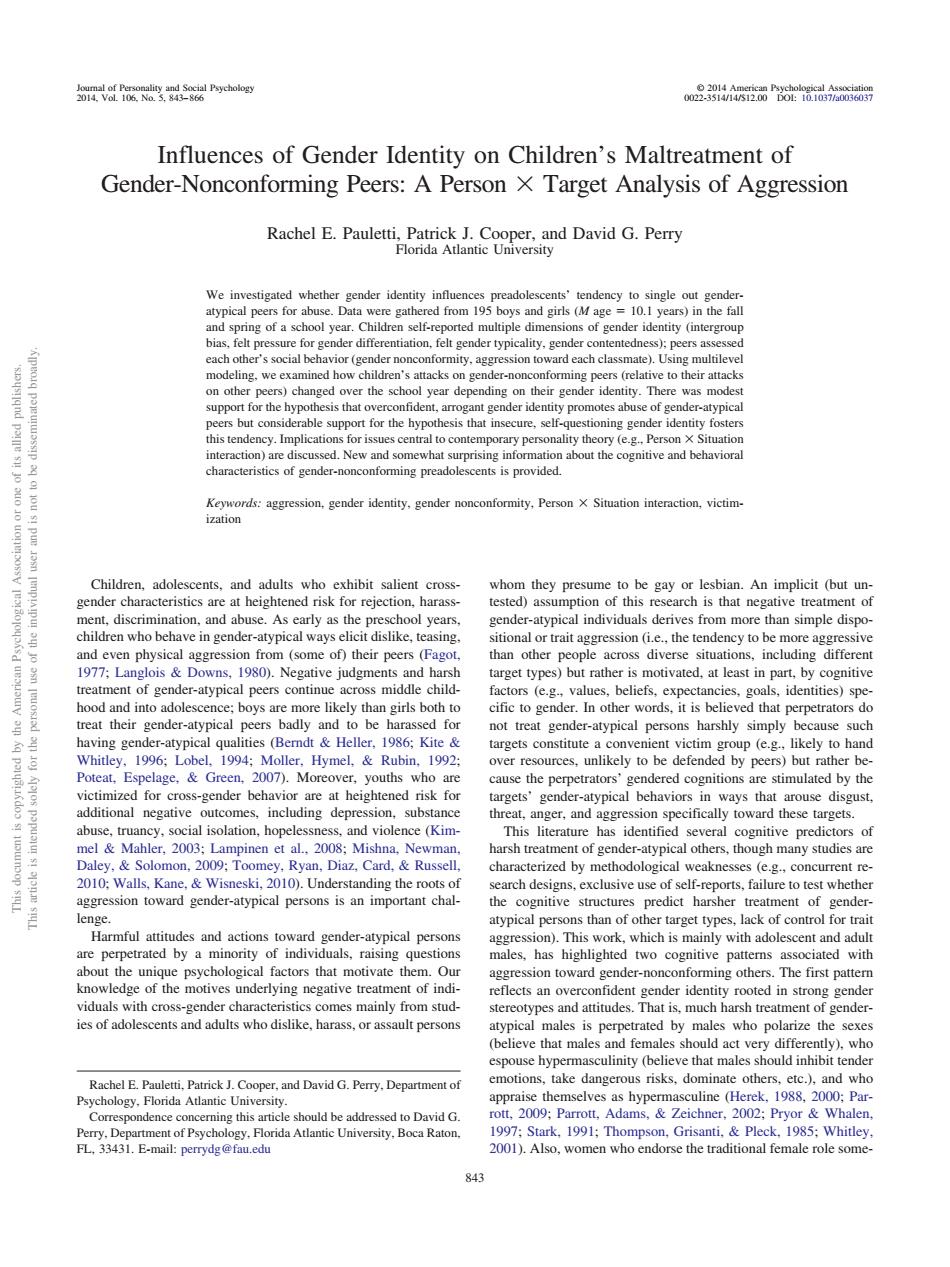正在加载图片...

Vany 8hs波温 Influences of Gender Identity on Children's Maltreatment of Gender-Nonconforming Peers:A Person X Target Analysis of Aggression Rachel E. edwhether gen to t es abuse of gend eh is 7andanaltoconl adults who exhihit salien ol year nder-atypica individu simple disp nd even physical aggr ssion from (some of)their peers situ 9 ing gender. ical qualities (Bemdt Heller 1986:Kite n ieg likely to hand 1996: 1994: M Hymel.&R ubin. to be defended by pers)but rather b for cross-gender behay re at heiel arouse d ing dep sub ger,ar 2003: Lam Mishna.Ne tre 010 Walls Kane Wisneski 2010)Understanding the oots of wea con aggression toward gender-atypical persons is an important chal- the ognitive structures predict harsher treatment of gende armful attitudes and actions to with con t and I by has two cognitive pat ated wit tives underlyin negative treatment of in cts an der identity rooted in st ende nd att Tha trea d fema and who elves as hype culine(Herek.:Par ponden 1997S Pleck 1985:white 2001).Also.women who endorse the traditional female role some 43Influences of Gender Identity on Children’s Maltreatment of Gender-Nonconforming Peers: A Person Target Analysis of Aggression Rachel E. Pauletti, Patrick J. Cooper, and David G. Perry Florida Atlantic University We investigated whether gender identity influences preadolescents’ tendency to single out genderatypical peers for abuse. Data were gathered from 195 boys and girls (M age 10.1 years) in the fall and spring of a school year. Children self-reported multiple dimensions of gender identity (intergroup bias, felt pressure for gender differentiation, felt gender typicality, gender contentedness); peers assessed each other’s social behavior (gender nonconformity, aggression toward each classmate). Using multilevel modeling, we examined how children’s attacks on gender-nonconforming peers (relative to their attacks on other peers) changed over the school year depending on their gender identity. There was modest support for the hypothesis that overconfident, arrogant gender identity promotes abuse of gender-atypical peers but considerable support for the hypothesis that insecure, self-questioning gender identity fosters this tendency. Implications for issues central to contemporary personality theory (e.g., Person Situation interaction) are discussed. New and somewhat surprising information about the cognitive and behavioral characteristics of gender-nonconforming preadolescents is provided. Keywords: aggression, gender identity, gender nonconformity, Person Situation interaction, victimization Children, adolescents, and adults who exhibit salient crossgender characteristics are at heightened risk for rejection, harassment, discrimination, and abuse. As early as the preschool years, children who behave in gender-atypical ways elicit dislike, teasing, and even physical aggression from (some of) their peers (Fagot, 1977; Langlois & Downs, 1980). Negative judgments and harsh treatment of gender-atypical peers continue across middle childhood and into adolescence; boys are more likely than girls both to treat their gender-atypical peers badly and to be harassed for having gender-atypical qualities (Berndt & Heller, 1986; Kite & Whitley, 1996; Lobel, 1994; Moller, Hymel, & Rubin, 1992; Poteat, Espelage, & Green, 2007). Moreover, youths who are victimized for cross-gender behavior are at heightened risk for additional negative outcomes, including depression, substance abuse, truancy, social isolation, hopelessness, and violence (Kimmel & Mahler, 2003; Lampinen et al., 2008; Mishna, Newman, Daley, & Solomon, 2009; Toomey, Ryan, Diaz, Card, & Russell, 2010; Walls, Kane, & Wisneski, 2010). Understanding the roots of aggression toward gender-atypical persons is an important challenge. Harmful attitudes and actions toward gender-atypical persons are perpetrated by a minority of individuals, raising questions about the unique psychological factors that motivate them. Our knowledge of the motives underlying negative treatment of individuals with cross-gender characteristics comes mainly from studies of adolescents and adults who dislike, harass, or assault persons whom they presume to be gay or lesbian. An implicit (but untested) assumption of this research is that negative treatment of gender-atypical individuals derives from more than simple dispositional or trait aggression (i.e., the tendency to be more aggressive than other people across diverse situations, including different target types) but rather is motivated, at least in part, by cognitive factors (e.g., values, beliefs, expectancies, goals, identities) specific to gender. In other words, it is believed that perpetrators do not treat gender-atypical persons harshly simply because such targets constitute a convenient victim group (e.g., likely to hand over resources, unlikely to be defended by peers) but rather because the perpetrators’ gendered cognitions are stimulated by the targets’ gender-atypical behaviors in ways that arouse disgust, threat, anger, and aggression specifically toward these targets. This literature has identified several cognitive predictors of harsh treatment of gender-atypical others, though many studies are characterized by methodological weaknesses (e.g., concurrent research designs, exclusive use of self-reports, failure to test whether the cognitive structures predict harsher treatment of genderatypical persons than of other target types, lack of control for trait aggression). This work, which is mainly with adolescent and adult males, has highlighted two cognitive patterns associated with aggression toward gender-nonconforming others. The first pattern reflects an overconfident gender identity rooted in strong gender stereotypes and attitudes. That is, much harsh treatment of genderatypical males is perpetrated by males who polarize the sexes (believe that males and females should act very differently), who espouse hypermasculinity (believe that males should inhibit tender emotions, take dangerous risks, dominate others, etc.), and who appraise themselves as hypermasculine (Herek, 1988, 2000; Parrott, 2009; Parrott, Adams, & Zeichner, 2002; Pryor & Whalen, 1997; Stark, 1991; Thompson, Grisanti, & Pleck, 1985; Whitley, 2001). Also, women who endorse the traditional female role someRachel E. Pauletti, Patrick J. Cooper, and David G. Perry, Department of Psychology, Florida Atlantic University. Correspondence concerning this article should be addressed to David G. Perry, Department of Psychology, Florida Atlantic University, Boca Raton, FL, 33431. E-mail: perrydg@fau.edu This document is copyrighted by the American Psychological Association or one of its allied publishers. This article is intended solely for the personal use of the individual user and is not to be disseminated broadly. Journal of Personality and Social Psychology © 2014 American Psychological Association 2014, Vol. 106, No. 5, 843– 866 0022-3514/14/$12.00 DOI: 10.1037/a0036037 843�